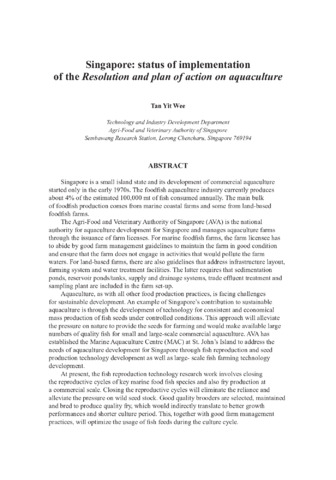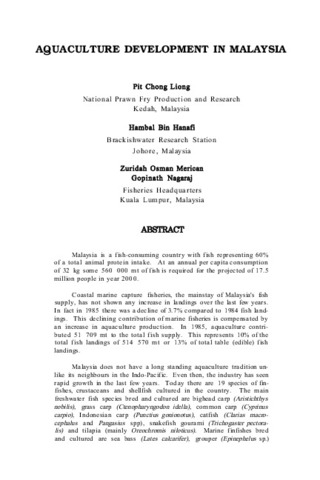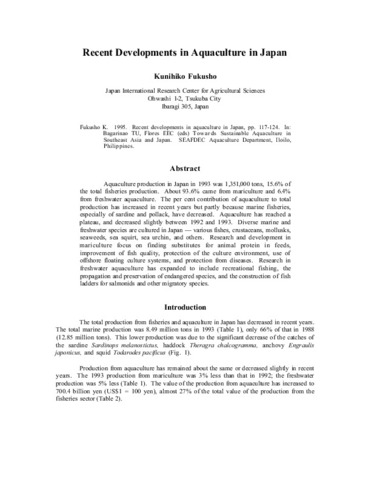Singapore: Status of implementation of the resolution and plan of action on aquaculture.
- Global styles
- MLA
- Vancouver
- Elsevier - Harvard
- APA
- Help
Share
Abstract
Singapore is a small island state and its development of commercial aquaculture started only in the early 1970s. The foodfish aquaculture industry currently produces about 4% of the estimated 100,000 mt of fish consumed annually. The main bulk of foodfish production comes from marine coastal farms and some from land-based foodfish farms.
The Agri-Food and Veterinary Authority of Singapore (AVA) is the national authority for aquaculture development for Singapore and manages aquaculture farms through the issuance of farm licenses. For marine foodfish farms, the farm licensee has to abide by good farm management guidelines to maintain the farm in good condition and ensure that the farm does not engage in activities that would pollute the farm waters. For land-based farms, there are also guidelines that address infrastructure layout, farming system and water treatment facilities. The latter requires that sedimentation ponds, reservoir ponds/tanks, supply and drainage systems, trade effluent treatment and sampling plant are included in the farm set-up.
Aquaculture, as with all other food production practices, is facing challenges for sustainable development. An example of Singapore s contribution to sustainable aquaculture is through the development of technology for consistent and economical mass production of fish seeds under controlled conditions. This approach will alleviate the pressure on nature to provide the seeds for farming and would make available large numbers of quality fish for small and large-scale commercial aquaculture. AVA has established the Marine Aquaculture Centre (MAC) at St. John's Island to address the needs of aquaculture development for Singapore through fish reproduction and seed production technology development as well as large- scale fish farming technology development.
At present, the fish reproduction technology research work involves closing the reproductive cycles of key marine food fish species and also fry production at a commercial scale. Closing the reproductive cycles will eliminate the reliance and alleviate the pressure on wild seed stock. Good quality brooders are selected, maintained and bred to produce quality fry, which would indirectly translate to better growth performances and shorter culture period. This, together with good farm management practices, will optimize the usage offish feeds during the culture cycle.
AVA is looking into the use of vaccination for fish health management purpose, to reduce the reliance on prophylactic drugs in the future. Antibiotics or chemicals if not administered properly for treatment may have negative consequences. One of them is the presence of drug residues in aquatic products which has food safety and health concerns. Other issues include adverse effects on the environment such as build-up resistance of pathogens.
In the past, the focus of attention in aquaculture management had been on increasing yield by culture practices, with a view to short-term economic viability. With the current rate of depleting marine resources, there is an urgent need to develop aquaculture in a sustainable way. Current efforts and future developments such as implementation of surveillance programmes, personnel training, fish nutrition and feeding, fish health, the establishment of good aquaculture practices, monitoring of the fish farming environment seawater re-use and information sharing will facilitate working towards the development of sustainable aquaculture in Singapore.
Suggested Citation
Wee, T. Y. (2011). Singapore: Status of implementation of the resolution and plan of action on aquaculture. In B. O. Acosta, R. M. Coloso, E. G. T. de Jesus-Ayson, & J. D. Toledo (Eds.), Sustainable aquaculture development for food security in Southeast Asia towards 2020. Proceedings of the Regional Technical Consultation on Sustainable Aquaculture Development in Southeast Asia Towards 2020 (pp. 113-114). Tigbauan, Iloilo, Philippines: SEAFDEC Aquaculture Department.
Type
Conference paperISBN
9789718511992
Related items
Showing items related by title, author, creator and subject.
-
Aquaculture development in Malaysia
Liong, Pit Chong.; Hanafi, Hambal Bin.; Merican, Zuridah Osman.; Nagaraj, Gopinath. (Aquaculture Department, Southeast Asian Fisheries Development Center, 1988)Malaysia is a fish-consuming country with fish representing 60% of a total animal protein intake. At an annual per capita consumption of 32 kg some 560 000 mt of fish is required for the projected of 17.5 million people ... -
Recent developments in aquaculture in Japan
Fukusho, K. (Aquaculture Department, Southeast Asian Fisheries Development Center, 1995)Aquaculture production in Japan in 1993 was 1,351,000 tons, 15.6% of the total fisheries production. About 93.6% came from mariculture and 6.4% from freshwater aquaculture. The per cent contribution of aquaculture to total ... -
Aquaculture development in Thailand
Sirikul, Boonsong; Luanprida, Somsak; Chaiyakam, Kanit; Sriprasert, Revadee (Aquaculture Department, Southeast Asian Fisheries Development Center, 1988)Aquaculture practised in Thailand is in the form of pond culture and cage culture in freshwater, brackishwater and coastal areas. The main species cultured include freshwater prawns, brackishwater shrimp, cockles, mussels, ...






